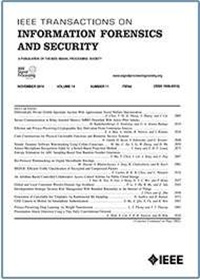基于匿名增强顺序多签名者环签名的IoMT安全医疗数据共享
IF 8
1区 计算机科学
Q1 COMPUTER SCIENCE, THEORY & METHODS
IEEE Transactions on Information Forensics and Security
Pub Date : 2025-03-29
DOI:10.1109/TIFS.2025.3574959
引用次数: 0
摘要
医疗物联网(IoMT)已经引起了学术界和医疗机构的广泛关注。然而,IoMT中涉及的敏感医疗数据引发了安全和隐私问题。为了缓解这些问题,环签名作为一种适当的解决方案浮出水面,它提供了不可伪造性和匿名性。不幸的是,大多数多签名者环签名方案需要预定数量的签名者,并且很难动态调整。此外,传统环签名对IoMT的适应性有限,因为它们依赖于单个实体。如何有效地为不同实体(如患者和医生)的用户定义不同的签名权限是一个挑战。因此,构建动态多签名者环签名是当前研究的重要课题。在本文中,我们提出了一种匿名增强的顺序多签名者环签名方案ASMR,用于IoMT中安全的医疗数据共享。ASMR包含两个不同的环,PR和DR,分别适用于患者和医生。它允许PR中的患者匿名签署DR中的医生拥有的电子医疗记录(EHR),从而克服了现有方法中对单一实体的依赖,同时增强了签名的匿名性。同时,ASMR引入了签名链的概念,允许DR中的多个用户按顺序对信息进行共同签名。此外,它确保每个生成的签名都是可跟踪的,从而提供了一个透明的系统。我们还在随机oracle模型中正式证明了ASMR的安全性。综合性能评估表明,ASMR在计算和存储开销方面都很出色。在最好的情况下,与现有技术相比,计算开销减少了大约$4.7\times $ - $61.7\times $,而存储开销减少了大约$26.7\times $ - $212.8\times $。本文章由计算机程序翻译,如有差异,请以英文原文为准。
Anonymity-Enhanced Sequential Multi-Signer Ring Signature for Secure Medical Data Sharing in IoMT
Internet of Medical Things (IoMT) has garnered significant research attention from both academic and medical institutions. However, the sensitive medical data involved in IoMT raises security and privacy concerns. To mitigate these, ring signature has surfaced as a proper solution, which offers unforgeability and anonymity. Unfortunately, most multi-signer ring signature schemes require a predetermined number of signers and are difficult to adjust dynamically. Additionally, traditional ring signatures have limited adaptability for IoMT due to their reliance on a single entity. It is challenging to effectively define different signature permissions for users of various entities, such as patients and doctors. Therefore, research focusing on constructing a dynamic multi-signer ring signature for multi-party participation remains a critical and ongoing challenge. In this paper, we present ASMR, an anonymity-enhanced sequential multi-signer ring signature scheme for secure medical data sharing in IoMT. ASMR contains two different rings, PR and DR, for patients and doctors, respectively. It allows patients in PR to anonymously sign their electronic healthcare record (EHR) owned by doctors in DR, overcoming the reliance on a single entity in existing approaches while enhancing the anonymity of the signature. Meanwhile, ASMR introduces the concept of signature chaining, allowing multiple users in DR to co-sign information in sequence. In addition, it ensures that each generated signature is traceable, offering a transparent system. We also formally prove the security of ASMR in the random oracle model. Comprehensive performance evaluations indicate that ASMR excels in both computational and storage overhead. In the best case, computational overhead is reduced by approximately $4.7\times $ - $61.7\times $ , while storage overhead is reduced by approximately $26.7\times $ - $212.8\times $ compared to prior arts.
求助全文
通过发布文献求助,成功后即可免费获取论文全文。
去求助
来源期刊

IEEE Transactions on Information Forensics and Security
工程技术-工程:电子与电气
CiteScore
14.40
自引率
7.40%
发文量
234
审稿时长
6.5 months
期刊介绍:
The IEEE Transactions on Information Forensics and Security covers the sciences, technologies, and applications relating to information forensics, information security, biometrics, surveillance and systems applications that incorporate these features
 求助内容:
求助内容: 应助结果提醒方式:
应助结果提醒方式:


